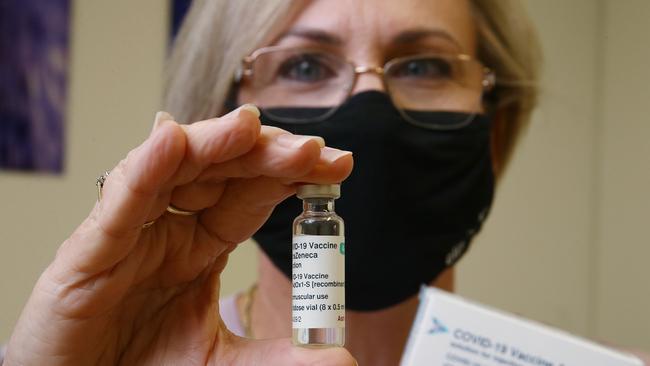Coronavirus: Mystery of 2.7 million ‘missing’ vaccine doses
The government has taken delivery of 4.3m doses of COVID-19 vaccines but as of Sunday just under 1.6m shots had been administered.

The Morrison government has taken delivery of 4.3 million doses of COVID-19 vaccines but as of Sunday just under 1.6 million shots had been administered.
That means about two out of three doses that have been supplied by Pfizer and AstraZeneca, batch tested and released by the regulator, have not been given to people.
Where could those remaining 2.7 million doses be? Are they in transit, storage, in GPs’ fridges, set aside by officials for a second dose, or just not yet recorded on the immunisation log?
The government maintains the picture is brighter, with an “estimated dose utilisation rate of 75 per cent”. Only 861,613 available doses have not been administered, according to Health Department figures released on Monday. A spokesman for Health Minister Greg Hunt told The Australian contingency for second doses and the delivery schedule explained the discrepancy, and that regulators were moving swiftly.
“So far the Therapeutic Goods Administration has cleared every batch on the day it has received the data. We are always delivering future supplies ahead of the coming week,” he said.
How could supplied doses from Big Pharma and unused doses seemingly be 1.8 million apart?
Let’s take AstraZeneca, which has delivered 717,000 doses from overseas, while an additional 2.6 million doses have been made locally by CSL. We know this from batch release data from the TGA. So far, the TGA has tested, passed and released 13 batches of the local product and three from overseas.
Now consider the Pfizer product. As of Friday, around 615,000 doses had been administered, according to the TGA. Pfizer says the company has met its target to deliver one million doses by the end of March. There is a Pfizer batch currently in testing with the TGA. Some of that outstanding Pfizer supply has been set aside for a second jab, which is delivered three weeks after the first. AstraZeneca has a 12-week period between doses.
So how to explain the large gap? Here’s how Health records the rollout progress.
For starters, the number of doses distributed, which Health defines as “total doses delivered per logistics provider data”, is just over three million, which is 1.3 million less than the number tested and released by the TGA.
Next, the number of doses that are “available”, defined as “stock on hand at sites and is based on weeks 1-7 deliveries (i.e. does not include those deliveries made in week 8, which would not have been available for administration” is just under 2.5 million.
Then there’s a figure for “wastage” of 10 per cent of available doses, so that equates to 250,000 doses, which the department says is in line with international standards. Finally, we get to the number of doses administered, which by Sunday had increased to 1,586,252. Add the wastage to the number of reported vaccinations, divided by the number of doses deemed as available and that’s how you get to the department’s calculation of a 75 per cent strike rate.
Over the weekend the number of vaccinations completed rose by almost 90,000. That’s impressive over a couple of days, given there’s almost no rollout on weekends. But take a look at the footnotes and we find the number of doses administered in primary care rose by 86,316 in a single day, due to a “data update” of 80,560 vaccinations completed before Saturday, and 5756 reported in the last 24 hours.
Sources familiar with vaccine supply, logistics contractors and the rollout strategy say GPs and primary providers are the weak point in the information chain. It’s another layer of record keeping, and a new one, amid all the other compliance obligations.
According to Health, nationally reported figures are obtained from a variety of sources. “Vaccinations numbers in primary care, which covers general practice (GP), general practice respiratory clinics (GPRC) and Aboriginal community controlled health services (ACCHS) are all taken from the Australian Immunisation Register,” the department said.
“Vaccination numbers for commonwealth aged-care and disability facilities, as well as those for state and territory clinics, are taken from daily reports that are provided to the Vaccine Operations Centre by vaccination providers and the states and territories.”
There are currently 4303 GP sites involved in the rollout.
The Australian understands there is rising tension between vaccine suppliers and those at the centre of the government’s rollout strategy, doctors.
Last week, the president of the Australian Medical Association, Omar Khorshid, told ABC radio that “the only handbrake on our GP rollout of AstraZeneca is the supply”. On Monday, Dr Khorshid made a presentation to national cabinet on the vaccine rollout by GPs and other primary providers and the ongoing role for the sector. In a statement, Scott Morrison said: “National cabinet reinforced that general practice will continue to be the primary model of rolling out vaccinations for Australians over 50 years of age.”








To join the conversation, please log in. Don't have an account? Register
Join the conversation, you are commenting as Logout